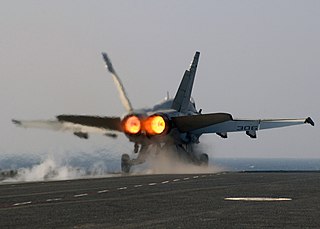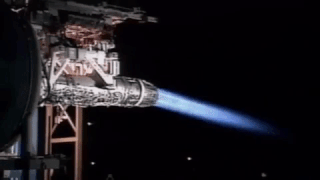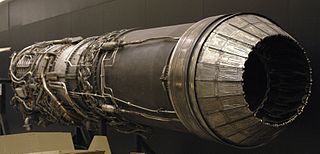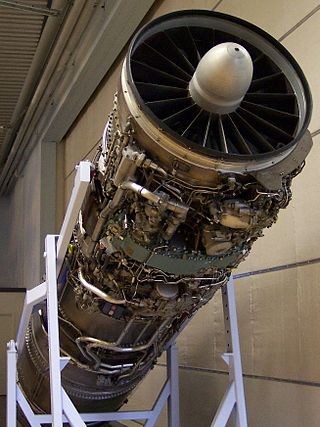Types of nozzle

Fixed-area nozzle
Non-afterburning subsonic engines have nozzles of a fixed size because the changes in engine performance with altitude and subsonic flight speeds are acceptable with a fixed nozzle. This is not the case at supersonic speeds as described for Concorde below.
With low area ratio
At the other extreme, some high bypass ratio civil turbofans control the fan working line by using a convergent-divergent nozzle with an extremely low (less than 1.01) area ratio on the bypass (or mixed exhaust) stream. At low airspeeds, such a setup causes the nozzle to act as if it had variable geometry by preventing it from choking and allowing it to accelerate and decelerate exhaust gas approaching the throat and divergent section, respectively. Consequently, the nozzle exit area controls the fan match, which, being larger than the throat, pulls the fan working line slightly away from surge. At higher flight speeds, the ram rise in the intake chokes the throat and causes the nozzle's area to dictate the fan match; the nozzle, being smaller than the exit, causes the throat to push the fan working line slightly toward surge. This is not a problem, however, for a fan's surge margin is much greater at high flight speeds.
In rockets (with high area ratio)

Rocket motors also employ convergent-divergent nozzles, but these are usually of fixed geometry, to minimize weight. Because of the high pressure ratios associated with rocket flight, rocket motor convergent-divergent nozzles have a much greater area ratio (exit/throat) than those fitted to jet engines.
Variable-area for afterburning
The afterburners on combat aircraft require a bigger nozzle to prevent adversely affecting the operation of the engine. The variable area iris [9] nozzle consists of a series of moving, overlapping petals with a nearly circular nozzle cross-section and is convergent to control the operation of the engine. If the aircraft is to fly at supersonic speeds, the afterburner nozzle may be followed by a separate divergent nozzle in an ejector nozzle configuration, as below, or the divergent geometry may be incorporated with the afterburner nozzle in the variable geometry convergent-divergent nozzle configuration, as below.
Early afterburners were either on or off and used a 2-position clamshell, or eyelid, nozzle which gave only one area available for afterburning use. [10]
Ejector
Ejector refers to the pumping action of the very hot, high speed, engine exhaust entraining (ejecting) a surrounding airflow which, together with the internal geometry of the secondary, or diverging, nozzle controls the expansion of the engine exhaust. At subsonic speeds, the airflow constricts the exhaust to a convergent shape. When afterburning is selected and the aircraft speeds up, the two nozzles dilate, which allows the exhaust to form a convergent-divergent shape, speeding the exhaust gasses past Mach 1. More complex engine installations use a tertiary airflow to reduce exit area at low speeds. Advantages of the ejector nozzle are relative simplicity and reliability in cases where the secondary nozzle flaps are positioned by pressure forces. The ejector nozzle is also able to use air which has been ingested by the intake but which is not required by the engine. The amount of this air varies significantly across the flight envelope and ejector nozzles are well suited to matching the airflow between the intake system and engine. Efficient use of this air in the nozzle was a prime requirement for aircraft that had to cruise efficiently at high supersonic speeds for prolonged periods, hence its use in the SR-71, Concorde and XB-70 Valkyrie.
A simple example of ejector nozzle is the fixed geometry cylindrical shroud surrounding the afterburning nozzle on the J85 installation in the T-38 Talon. [11] More complex were the arrangements used for the J58 (SR-71) and TF-30 (F-111) installations. They both used tertiary blow-in doors (open at lower speeds) and free-floating overlapping flaps for a final nozzle. Both the blow-in doors and the final nozzle flaps are positioned by a balance of internal pressure from the engine exhaust and external pressure from the aircraft flowfield.
On early J79 installations (F-104, F-4, A-5 Vigilante), actuation of the secondary nozzle was mechanically linked to the afterburner nozzle. Later installations had the final nozzle mechanically actuated separately from the afterburner nozzle. This gave improved efficiency (better match of primary/secondary exit area with high Mach number requirement) at Mach 2 (B-58 Hustler) and Mach 3 (XB-70). [12]
Variable-geometry convergent-divergent
Turbofan installations which do not require a secondary airflow to be pumped by the engine exhaust use the variable geometry C-D nozzle. [13] These engines don't require the external cooling air needed by turbojets (hot afterburner casing).
The divergent nozzle may be an integral part of the afterburner nozzle petal, an angled extension after the throat. The petals travel along curved tracks and the axial translation and simultaneous rotation increases the throat area for afterburning, while the trailing portion becomes a divergence with bigger exit area for more complete expansion at higher speeds. An example is the TF-30 (F-14). [14]
The primary and secondary petals may be hinged together and actuated by the same mechanism to provide afterburner control and high nozzle pressure ratio expansion as on the EJ200 (Eurofighter). [15] Other examples are found on the F-15, F-16, B-1B.
Additional features
Thrust-vectoring

Nozzles for vectored thrust include fixed geometry Bristol Siddeley Pegasus and variable geometry F119 (F-22).
Thrust-reversing
The thrust reversers on some engines are incorporated into the nozzle itself and are known as target thrust reversers. The nozzle opens up in two halves which come together to redirect the exhaust partially forward. Since the nozzle area has an influence on the operation of the engine (see below), the deployed thrust reverser has to be spaced the correct distance from the jetpipe to prevent changes in engine operating limits. [16] Examples of target thrust reversers are found on the Fokker 100, Gulfstream IV and Dassault F7X.
Noise-reducing
Jet noise may be reduced by adding features to the exit of the nozzle which increase the surface area of the cylindrical jet. Commercial turbojets and early by-pass engines typically split the jet into multiple lobes. Modern high by-pass turbofans have triangular serrations, called chevrons, which protrude slightly into the propelling jet.

















